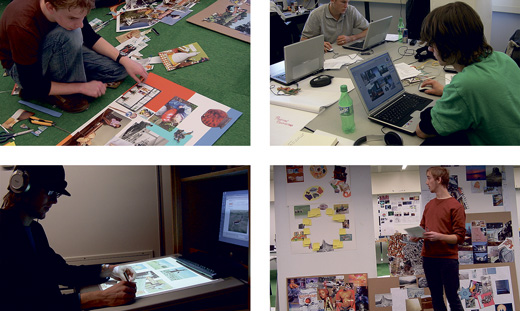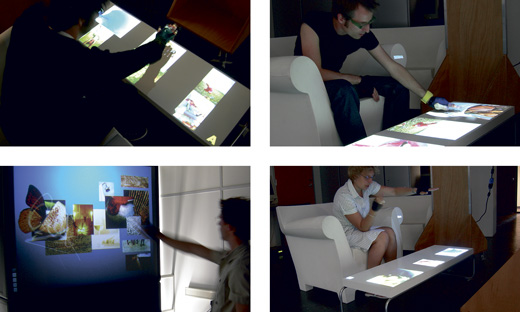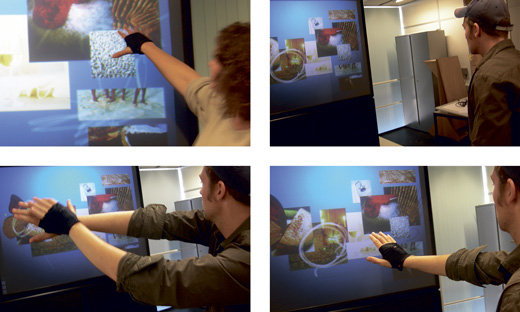Industrial Design doctoral candidate Lucero started his research in an unusual manner. “During research into ‘augmented reality’ the emphasis is mostly on technology, and only later on specific tasks and people that could profit from that technology, such as medical practitioners or architects”, says Lucero, who works for Nokia in Finland as a researcher. “I wanted to apply a different approach by first talking to people, designers in this case, and seeing how they work, and subsequently how technology can help them with a specific task such as making mood boards.”
Designers use mood boards because words are often inadequate for expressing or conveying an emotion or an atmosphere within a design team or in a discussion with a principal. “Your color red may differ from mine”. A butterfly can express tenderness or lightness.”

Students of Industrial Design make a mood board on paper, using a laptop and a prototype of electronic paper.
The traditional way of making a mood board –leafing through magazines and books, selecting pictures, making a composition and pasting it onto paper- is very time-consuming, however. “Then again, the process of skimming magazines and being temporarily somewhere else than behind your computer can also be inspiring.” Lucero investigated how the making of a mood board can be supported technologically, though in a way that indicates how designers wish to work.
Part of the research was that designers evaluated different ways of making mood boards: with paper, scissors and glue, with a laptop and with an ‘augmented reality’ prototype, also known as electronic paper. By means of this designers could manipulate pictures by using a reflection card on a horizontal board on which the pictures were projected. It was hardly surprising that the electronic paper was favored by the designers participating. However, this machine also necessitated the partial use of a mouse and a keyboard, which complicated the process. ‘A keyboard and a mouse spoil the illusion that you are working with your hands’, was how one of them described it.

The dialogue lab in Finland, set up so as to look like a genuine design studio.
Lucero interviewed both Dutch and Finnish designers in their working environment. “I adopted the pose of a pupil to whom they explained their working method.” He also invited other designers in a lab environment, which he calls ‘dialogue labs’, so as to let the designers design their concept of a working environment of the future within only two hours. In this exercise the designers could also evaluate the lab itself lab. Lucero: “This lab had been set up in accordance with earlier findings about the various activities carried out by designers during the beginning of the design process, such as leafing through pictures and connecting, expanding and presenting mood boards.”

Closing discussion with a scale
model of the design studio in Playmobil.
The designers came up with a great number of ideas for improving their working environment, like a large ‘cut-and-paste’ board that enables a design team to work simultaneously and have an overview of the process. Or present a mood board on the ceiling whilst lying on the floor. “This ‘looking at the stars’ creates a relaxed and different way of looking”, Lucero explains.
During the final stage of his research Lucero made and tested a prototype of a ‘funky coffee table’ and a ‘funky wall’. Designers can leaf through pictures on the table by moving their hands across the table. “A rotating movement allows you to leaf through the pictures, but you can also pile pictures onto virtual stacks above the table and shift between layers by moving your hand up or down”, is Lucero’s comment.

Funky coffee table tool. You can leaf through digital pictures by moving your hands across the table.
“Both the funky coffee table and the special wall were evaluated as positive”, says Lucero. The special thing about the funky wall is that speech and gestures alike are recorded during the presentation of a mood board and are stored in significant segments. When a principal or a client wants to look back at the presentation, they can simply go to the part of the mood board that appealed to them and see what was said about that particular section. “In that way a dimension is added to the merely linear structure provided by an ordinary PowerPoint presentation”, Lucero thinks.
The doctoral candidate finds it a valuable experience to give users a role in the design process. “Lack of funds or time are insufficient reasons for leaving users outside your design. I understand that in normal circumstances you do not have four years like I had to award a central place to users during the design process. Still, listening to users at the beginning of the design process up to the making of a prototype provides valuable insights”, concludes Lucero.

The funky wall.
|



